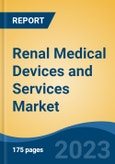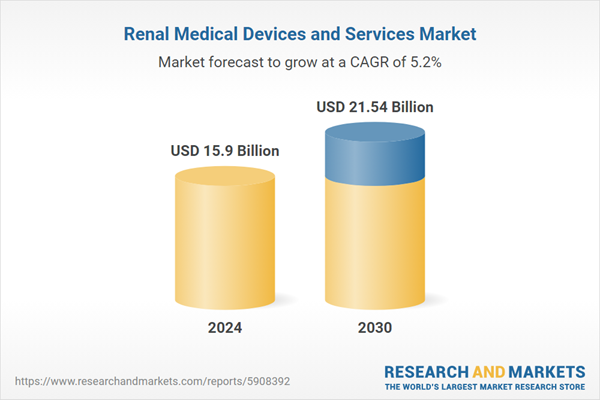Speak directly to the analyst to clarify any post sales queries you may have.
10% Free customizationThis report comes with 10% free customization, enabling you to add data that meets your specific business needs.
The market encompasses a wide range of technologies, including imaging devices such as ultrasound machines, CT scanners, and MRI machines, which are used to diagnose kidney-related conditions such as tumors, cysts, and kidney stones. The rising prevalence of kidney diseases, such as chronic kidney disease (CKD) and end-stage renal disease (ESRD), is a major factor driving market growth. Contributing factors include aging populations, diabetes, hypertension, and lifestyle-related health issues, which are expanding the patient base requiring renal medical devices and services.
**Key Market Drivers**
**Increasing Prevalence of Chronic Kidney Disease (CKD) and End-Stage Renal Disease (ESRD)**
The growing incidence of CKD and ESRD is a key driver of expansion in the Global Renal Medical Devices and Services Market. As kidney disease rates rise globally, the demand for treatments, devices, and services continues to grow. Approximately 700 million people globally are affected by CKD, and when considering the additional burden of Acute Kidney Injury (AKI) and kidney failure, the number rises to about 850 million, impacting over 10% of the world’s population. This figure is likely an underrepresentation due to the lack of widespread early detection and screening programs. The progression of CKD to ESRD demands continuous medical interventions, primarily dialysis and related therapies.
As more patients develop ESRD, the need for dialysis machines, kidney monitors, filtration systems, and other essential renal devices increases, driving market growth. Additionally, the rising prevalence of risk factors such as diabetes, hypertension, and obesity further contributes to the global burden of renal disease, highlighting the urgent need for effective management strategies. Diabetes, in particular, is the leading cause of kidney disease, while hypertension and diabetes together account for two-thirds of new kidney failure cases.
**Key Market Challenges**
**Economic Uncertainty**
Economic instability can influence various aspects of the market, including purchasing decisions, healthcare budgets, and investments in medical devices and services. During periods of economic uncertainty, healthcare facilities, including hospitals and clinics, may face budget constraints, leading to limitations on capital expenditures. As a result, investments in renal medical devices and services may be delayed. Economic challenges can also exert pricing pressure on medical device manufacturers and service providers, as healthcare organizations seek more cost-effective solutions, potentially affecting profit margins. Additionally, economic uncertainty can reduce funding for research and development initiatives, impeding innovation in renal medical devices. The market’s volatility, especially in terms of stock prices and investor confidence, may also be affected by economic conditions, as could patient behavior, with some opting to delay elective procedures or explore lower-cost alternatives.
**Key Market Trends**
**Home Hemodialysis**
Home hemodialysis is becoming increasingly popular, offering patients with ESRD the ability to undergo dialysis treatments in the comfort of their own homes. Many patients prefer this option as it provides greater flexibility and can be adapted to their personal schedules. This patient-centered approach has spurred demand for home hemodialysis devices and services. Patients undergoing home dialysis can experience better clinical outcomes due to the ability to dialyze more frequently or for longer durations.
Furthermore, home hemodialysis eliminates the need for frequent travel to healthcare facilities, reducing the burden on patients and their families. It can also decrease the risk of exposure to infections commonly found in healthcare settings. From a cost perspective, home hemodialysis offers a more affordable alternative by reducing the expenses associated with facility-based care. Manufacturers are developing more user-friendly and compact machines to facilitate home treatments, while telehealth and remote monitoring technologies enable healthcare providers to manage patients’ progress and adjust treatments as needed, enhancing both safety and effectiveness.
**Key Market Players**
- Abbott Laboratories Inc.
- B Braun Melsungen AG
- Baxter International Inc.
- Becton, Dickinson, and Company
- Boston Scientific Corporation
- DaVita Healthcare Partners, Inc.
- Fresenius SE & Co. KGaA
- Infomed SA
- Medtronic Inc.
- Nipro Corporation
The Global Renal Medical Devices and Services Market is segmented as follows:
**By Product:
**- Dialysis Equipment
- Renal Denervation Devices
- Wearable Artificial Kidney Device
- Distal Embolic Protection Devices
**By Application:
**- Kidney Failure
- Chronic Kidney Disease (CKD)
- End-Stage Kidney Disease (ESRD)
- Renal Kidney Stone Disease
- Hypertension
- Diabetes
- Others
**By Region:
**- North America (United States, Canada, Mexico)
- Asia-Pacific (China, India, South Korea, Australia, Japan)
- Europe (Germany, France, United Kingdom, Spain, Italy)
- South America (Brazil, Argentina, Colombia)
- Middle East & Africa (South Africa, Saudi Arabia, UAE)
The competitive landscape of the market includes a detailed analysis of major companies operating in the Global Renal Medical Devices and Services Market.
**Customizations Available**
This report can be customized according to the specific needs of a company. TechSci Research offers customizations such as the inclusion of detailed company profiles of additional market players (up to five).
This product will be delivered within 1-3 business days.
Table of Contents
Companies Mentioned
- Abbott Laboratories Inc.
- B Braun Melsungen AG
- Baxter International Inc
- Becton, Dickinson, and Company
- Boston Scientific Corporation
- DaVita Healthcare Partners, Inc
- Fresenius SE & Co. KGaA
- Infomed SA
- Medtronic Inc.
- Nipro Corporation
Table Information
| Report Attribute | Details |
|---|---|
| No. of Pages | 180 |
| Published | February 2025 |
| Forecast Period | 2024 - 2030 |
| Estimated Market Value ( USD | $ 15.9 Billion |
| Forecasted Market Value ( USD | $ 21.54 Billion |
| Compound Annual Growth Rate | 5.1% |
| Regions Covered | Global |
| No. of Companies Mentioned | 10 |









